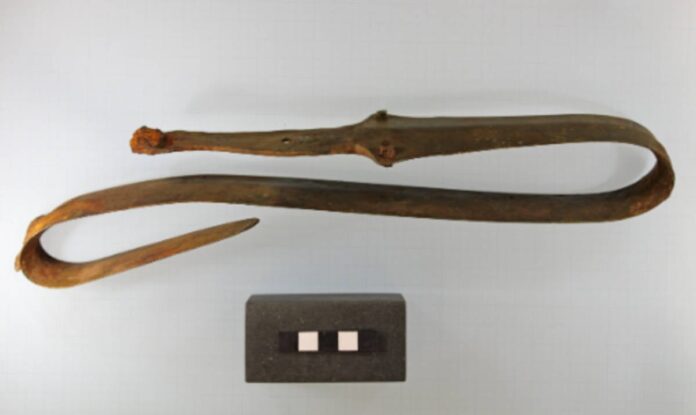A Bronze Age sword, ritually bent before being deposited as an offering, has been unearthed in Værebro Ådal by a metal detectorist on his first outing. Described as “a very rare find”, an entire hoard with several objects dated to the time of the transition between the Bronze Age and the Iron Age were discovered in a bog near Veksø, including a beautiful neck ring. What makes the finds even more precious is that there are very few finds in bogs from the late Bronze Age.
A Continuity of the Offering Tradition
According to archaeologist Emil Winther Struve, speaking to the Danish museum organization ROMU, the bending rendered the sword unusable as a weapon, but the design and materials made it a valuable offering.
“We have many hoards from the early and middle Bronze Age, where bronze items appear in bogs, but far fewer from the late Bronze Age. The offering tradition, which was so visible and dominant in earlier periods, is retreating by the end of the Bronze Age,” said Struve, responsible for archaeological excavations in Egedal Municipality. This indicates that the objects were buried around 500 BC, approximately 2,500 years ago.
The large neck ring with the special polygonal (multi-edged) cross-section has been excavated. (Palle Østergaard Sørensen/ROMU)
The archaeologists found that the offering tradition had not disappeared completely – two small bronze axes (Celts), a ritually bent bronze sword with iron rivets in the handle, two to three large anklets (vulstringe), a possible fragment of a large brooch, and an object that archaeologists have seen in other finds but have yet to identify, completed the hoard.
Just days later, Falsby ended up discovered another magnificent offering only 70 meters (230 feet) from the first site: the aforementioned large, bronze, neck ring. With a unique design, this neck ring is only the second of its kind found in Denmark! It is believed to have been produced along the Polish Baltic coast, where such items are more common, and reached Denmark via maritime trade connections.

A series of bead rings emerged from the ground like this one. Bead rings are a term for large, voluminous ankle rings that are designed to impress. Katrine Ipsen Kjær/ROMU)
Incidentally, in Værebro Ådal, two small bronze figurines of women wearing neck rings have been found earlier, and are contemporaneous with the Egedal find; clearly a culture of Bronze Age traditions remained in continuity, and intersected with the local elite holding onto traditions and established status quo.
Bronze Age Denmark: A More Interconnected Europe
The sword’s design suggests it was not produced in Denmark but likely imported from the Alpine region, north of the Alps, an area home to the Hallstatt culture, which rose to prominence in late Bronze Age Europe, reports The Heritage Daily.
“Their swords were designed differently from earlier ones, perhaps reflecting a change in their use. Earlier swords were slender and may have been used for stabbing. But now they are sturdier, heavier, and more suited for slashing. The Hallstatt culture, which spread rapidly, embodied a warrior ideal with a strong focus on conquest, war, and conflict. The sword may reflect this mindset,” Struve explained.
Previously, the Smørumovre Hoard (1851) with 163 items from the early Bronze Age, and The Veksø Helmets (1942), dating to the middle Bronze Age, had been found. The archaeology team is pleased that now they have a major hoard from every era. The Danish Bronze Age (1700-500 BC) was renowned for the domestication of the horse, expansion of trade connections between various parts of Europe, and most importantly, burial mounds – Denmark alone has yielded evidence of 20,000 mounds!
The artifacts are currently in possession by the National Museum, in the form of “danefæ”, i.e., treasure trove. “We have very few swords of this type in Denmark. It would be exciting to analyze the bronze and iron to determine precisely where it was produced. This, however, will take some time. The preservation of the iron rivets in the handle is especially rare, and the sword will undoubtedly be stunning once the National Museum’s experts have conserved it,” concludes an excited Struve.
Top image: The ritually bend sword found at Værebro Ådal, Veksø, Denmark. Source: Palle Østergaard Sørensen/ROMU
By Sahir Pandey




